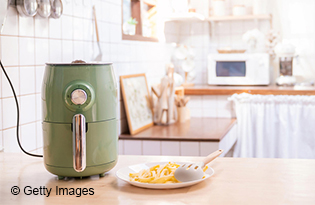Is hot air the new hot oil?
5/5/2025

Air fryers have become a staple on kitchen counters across America, reducing the amount of cooking oil needed to create that crisp, golden coating on the outside of your foods, while keeping the inside of the food moist.
In 2010, the Philips Air Fryer hit the shelves and revolutionized the way we "fry" foods. This cooking appliance relies on a process called Rapid Air Technology that utilizes a heating element and a fan that moves hot air very quickly around the food. You might recognize this method as convection cooking. It requires little to no oil, which greatly reduces fat and calories when compared to traditional deep-frying methods.
You might be asking, what's so bad about using oil?
We all need healthy fats in our diet, but the calories in even the healthiest of oils, such as olive oil and avocado oil, add up quickly. A little spritz or drizzle goes a long way when cooking in an air fryer. In addition, traditional deep-fried-in-oil foods can be high in trans fats, which can raise LDL cholesterol, increasing your risk of heart disease. With air frying at home, you have the option to choose your oil and how much you use.
Ready to dive in?
Here are some suggestions to get you started on this hot new way of cooking, as well as a recipe courtesy of the American Heart Association! Foods that lend themselves to air fryer cooking:
- Homemade French fries, tater tots or potato wedges.
- Vegetables, including Brussels sprouts, cauliflower, carrot or kale chips.
- Coconut shrimp, chicken parmesan, salmon bits and tofu steaks.
Check out this recipe for "Air Fryer Crispy (Un) Fried Chicken" from the American Heart Association.
Tamara Soerensen completed her bachelor's degree in biology at the University of California, Santa Barbara and her master's degree in nutrition at Bastyr University. She is a dietetic intern at Mayo Clinic in Rochester, Minnesota. Special interests include digestive health and the utilization of diet for disease prevention.
